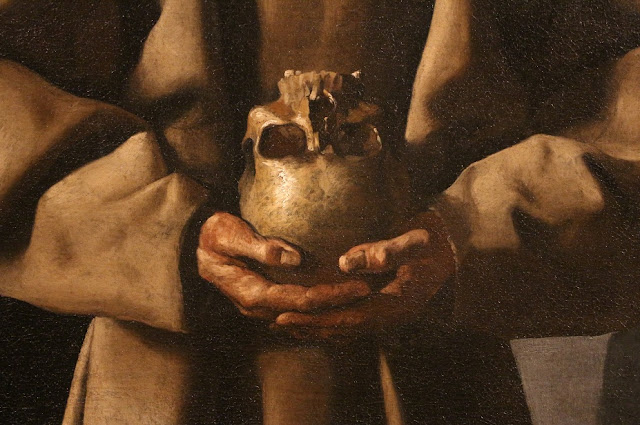Saint Francis by Zurbaran 1630
The "poverello of Assisi", one of the favorite saints of the post-Tridentine Catholic Reformation, was the saint that Zurbaran painted more times throughout his career. There are numerous representations of St. Francis with different iconographies: kneeling in prayer, in the miracle of the Porciuncula, during stigmatization or dead according to the vision of Pope Nicholas V. Of the saint in meditation there are many versions, especially if you also consider the who present workshop intervention. From the chromatic point of view, the browns and toasted tones of the saint stand out strongly illuminated against a gloomy background with a twilight landscape in the background.
Arranged in a frontal way, standing, holding a skull with the hands crossed and the head tilted towards it, this small meditative figure is, despite its small size, one of the most impressive among those painted by Zurbaran on this subject. The San Francisco of the Milwaukee Art Museum, of great size, is an autograph and extended repetition of the square of the Museum of San Luis. On both canvases the folds of the sayal, made in the same range of brown colors, fall vertically, briefly. Bare feet appear below the habit and the left one advances in the direction of the spectator. The bearded face is barely guessed overshadowed by the saint's crestfallen gesture and the pointed capirote. The peculiar format of the canvas is similar to that of the paintings of the only small altarpiece of the 17th century that is still preserved in situ in the church of San Alberto.
Francisco de Zurbaran (baptized November 7, 1598 – August 27, 1664) was a Spanish painter. He is known primarily for his religious paintings depicting monks, nuns, and martyrs, and for his still-lifes. Zurbaran gained the nickname "Spanish Caravaggio," owing to the forceful, realistic use of chiaroscuro in which he excelled.
St Francis is a 1659 painting of Francis of Assisi by Francisco de Zurbaran. It was the only work by the artist known in France before the 19th century. It seems to have been intended for a monastery in Madrid, before Maria Theresa of Spain gave it to the 'Colinettes' Franciscan monastery in Lyon.
This image is a public domain image, which means either that copyright has expired in the image or the copyright holder has waived their copyright. Franciscan Gallery charges for the access to high resolution copy of the image. Manually restoration was necessary in order to improve quality, without covering the original image.






Comments
Post a Comment